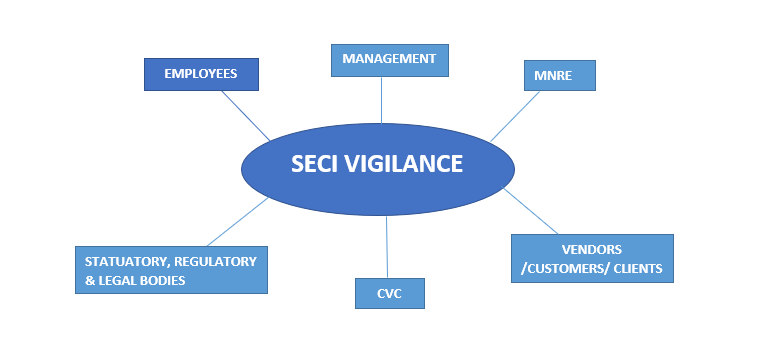
Vigilance Functions in SECI
SECI has vigilance department to ensure transparency, efficiency and integrity and adoption of best corporate practices in the working of organization. It seeks to promote the highest ethical standards in the organization.
The Vigilance Department plays an advisory role to the top management in matters pertaining to vigilance. The Department ensures implementation of laid down guidelines/procedures through preventive checks of tenders and contracts, execution of works, and other functions as well as carries out investigations into complaints. The department’s activities apart from investigation of complaints, ensures compliance to various regulations and guidelines as defined by CVC / Ministry of New and Renewable Energy/any other Regulatory and Statutory requirements. The department initiates proactive steps to ensure ethical work practices across the company. Along with the reactive and punitive response, the department takes preventive and reformative measures in improving the system in the organization.
As per the provision of Integrity Pact and relevant guidelines of Central Vigilance Commission, 02 numbers of Independent External Monitor (IEM) have also been appointed to examine complaints from the bidder and give their report to the Chief Executive of the organization and also to monitor compliance of the integrity pact. Vigilance strives to achieve its objective of promoting an impartial, fearless, and transparent environment in the functioning of the organisation by taking steps to prevent unethical practices.
The Role of Vigilance can be broadly divided into following heads:
Proactive Vigilance
It is creating awareness and educating all the employees on anti-corruption measures, simplification of rules and procedures, plugging loop holes in the system. To conduct Vigilance awareness programme to educate all to take clean, honest, effective and transparent decisions.
Preventive Vigilance
It plays an important role in strengthening the vigilance set up of any organization. Preventive vigilance sets up procedures and systems to restrain the acts of wrong doing and misconduct in the various areas of the functioning of the department.
Predictive Vigilance
It enables foreseeing in activity prejudicial to the interests of the organization and suggesting in advance corrective measures to be taken by the management against acts of misconduct, corruption, lapses.
Detective Vigilance
Punitive Vigilance
It includes investigation and collection of evidence and speedy departmental inquiries. Swift and deterrent action against the real culprits.
Corrective Vigilance
It includes analysis of results of detective vigilance and exploration of the reasons and contributory factors, finding solutions to stop recurrence and activate alarm signals, updating the practices/ procedures to keep pace with times.
Vigilance Activities
Role and Functions of Chief Vigilance Officer (CVO)
The Head of the Vigilance Department in SECI is Chief Vigilance Officer. The Chief Vigilance Officer (CVO) heads the Vigilance Division of the organization concerned and acts as an advisor to the chief executive in all matters pertaining to vigilance. CVO also provides a link between the organization and the Central Vigilance Commission on one hand and the organization & the Central Bureau of Investigation on the other. Vigilance functions to be performed by the CVO are of wide sweep and include
(i) Preventive Vigilance;
(ii) Punitive or reactive Vigilance;
(iii) Surveillance & detective Vigilance.
Even though detection and punishment of corruption and other malpractices are certainly important, what is more important is taking preventive measures instead of hunting for the guilty in the post corruption stage. Therefore, the role and functions of CVOs has been broadly divided in to two parts, which are (i) Preventive and (ii) Punitive.
